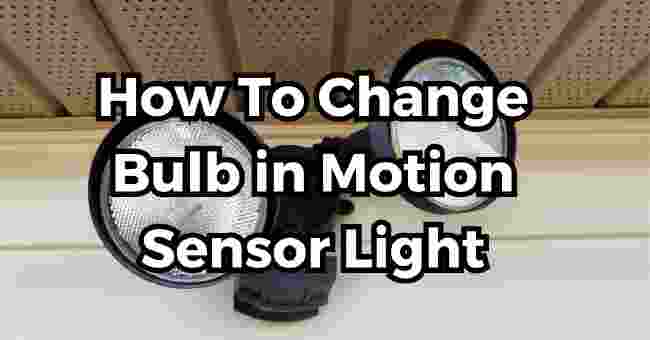Table of Contents
Do you wish to know how to change bulb in motion sensor light? Yes as homeowner, changing your motion senor light bulb is simple and it is easy to do by following some steps.
Last winter, all the outdoor motion sensor lights suddenly went dark. I felt so frustrated stumbling to the door in pitch blackness!
Why had the bulbs burnt out all at once? Were these special fixtures too complex for DIY bulb replacement?
After almost twisting an ankle, I knew things needed illumination. So my journey began figuring out how to safely change those finicky bulbs without electrocuting myself.
After researching and testing, I discovered some simple methods for overcoming each challenge.
Now I can’t wait to explain step-by-step how to change bulb in motion sensor light so you can also conquer finicky fixtures!
In this comprehensive DIY guide, we’ll walk you through the complete process of safely changing the bulb in a motion sensor light.
From understanding how they work to gathering supplies, disconnecting the power, accessing the bulb, and more – we’ve got you covered with simple step-by-step instructions and useful safety tips.
So read on to gain the confidence to tackle this project yourself!
Overview: Understanding Motion Sensor Lights
Before diving into the specifics of changing the bulb, let’s first build a foundation of understanding motion sensor light technology:
What is a Motion Sensor Light?
A motion sensor light is an outdoor lighting fixture that turns on automatically when it detects movement within its coverage area.
It incorporates a motion sensor – usually passive infrared (PIR) – along with a photocell light sensor to control illumination.
How Does it Work?
The passive infrared (PIR) motion sensor detects temperature changes caused by the motion of a person or animal within its field of view.
When motion is detected, the photocell light sensor checks ambient light levels. If below the preset threshold (i.e. at night), the fixture turns on the lights.
The fixture remains illuminated for a preset “on-time” after last detecting motion. This duration is adjustable on most models.
Key Benefits
- Hands-free illumination – Turns on/off automatically
- Enhanced security – Deters intruders via sudden illumination
- Energy efficiency – Only lights when needed
Now let’s look at why changing the bulb can be challenging in these versatile fixtures.
The Challenges on How To Change Bulb In Motion Sensor Light
While motion sensor fixtures provide some great benefits, their specialized design does create a few unique challenges when it’s time to replace a burnt-out bulb:
Difficult Access:
Motion sensor lights are usually mounted in high, hard-to-reach locations like eaves, ceilings, or tall poles. This makes accessing the fixture to change the bulb quite difficult.
Live Wires & Electrical Hazards:
These fixtures contain complex wiring and electrical components to power and control the bulbs as well as the motion sensor.
So changing the bulb risks exposure to live wires which creates the potential for nasty electrical shocks.
Special Bulb Requirements:
The bulbs in these fixtures have strict compatibility requirements like maximum wattage to avoid overloading.
So you can’t simply swap in any spare bulb you have on hand.
Let’s look at how we can work around these challenges safely and choose the right replacement LED bulb for the job.
Gathering Supplies: Tools & Materials Needed
Changing a motion sensor light bulb without the proper gear is next to impossible. So before getting started, ensure you gather all the necessary tools and materials:
Essential Safety Equipment
Your personal safety should be the top priority when working with any electrical fixture. The following safety gear is mandatory for the job:
- Electrical gloves – Protect hands from shocks
- Safety glasses – Prevent eye injuries
- Work boots – Insulate and stabilize
Having this protective equipment vastly reduces the risks inherent when handling electrical components. Don’t even think about attempting this project without them!
Tools for Access & Disassembly
You’ll need an assortment of hand tools to safely access, disassemble and reassemble the light fixture:
| Tool | Purpose |
| Step ladder | Safe access to elevated fixtures |
| Phillips screwdriver | Removing cover panel screws |
| Needle nose pliers | Gripping/twisting bulbs |
| Voltage tester | Verifying power disconnected |
A sturdy step ladder is absolutely vital for reaching elevated fixtures safely. Placement on a solid, level surface and maintaining 3 points of contact are also key for stability.
Voltage testers are crucial for verifying that the power is disconnected before handling any wiring. We’ll cover more on electrical safety shortly.
Bulb Replacement Selection
Choosing the right replacement bulb is critical for proper functioning of the motion controlled fixture.
Refer to any manufacturer documentation for explicit compatibility requirements. But in general you’ll need to match:
| Specification | Details |
| Bulb type | Typically compact fluorescent (CFL) or LED |
| Wattage | Check max rating for fixture |
| Light color | Match existing or choose new |
| Base type | Likely medium E26/E27 |
With the essential gear assembled, you’re ready to move onto the actual bulb replacement process safely. Let’s get to it!
Step 1: Turning Off Power at the Breaker
Before any work on an electrical fixture, the power must be disconnected at the breaker panel.
Attempting the bulb replacement while the motion sensor light circuit remains live risks dangerous shocks. So let’s focus first on safely cutting power:
Importance of Disconnecting Power Source
Working on “hot” or live electrical equipment can have severe consequences:
- Electric shock – Direct contact with live wires
- Falls – Shock reactions causing loss of stability
- Damage – Short circuits sparked by mistakes
By switching off the breaker, we completely isolate the fixture from power source eliminating all of these risks during the bulb replacement. Safety first always!
Identifying the Correct Breaker
Start by locating your main breaker panel, usually in the garage or basement. It will contain labeled switches that each control a specific circuit.
Identifying the correct one for the motion sensor light is our next task:
Reference any documentation – Check the label on the light fixture itself or any install paperwork for details on the connected circuit details. This should explicitly tell you which breaker controls power.
Test & elimination – If no docs available, flip breakers systematically while checking the light.
When the fixture loses power – you’ve found the right breaker. Kill power completely by switching to OFF.
Regardless of the approach, properly identifying and flipping the right breaker switch to OFF is crucial before moving to the fixture.
Step 2: Removing the Fixture Cover Panel
With power disconnected for safety, we can move on to accessing the internal components of the motion sensor.
This starts with taking off the outer cover panel using the following procedure:
Materials Needed
- Step ladder
- Phillips screwdriver
- Needle nose pliers (optional)
Removal Instructions
Here is the systematic process for safely removing the exterior housing:
- Position step ladder directly under fixture
- Identify screw locations
- Carefully remove each panel screw with screwdriver
- Fully loosen all screws before prying
- Gently pry-off panel with pliers if needed
- Avoid yanking or damaging wires
Take care when handling the removed cover panel. Set it gently on a soft surface to prevent cracks or breaking. We’ll need to reattach it once the new bulb is installed.
With the cover panel removed, we now have clear access to the bulb socket and electrical components. Let’s start replacing that bad bulb!
Step 3: Extracting the Faulty Bulb
Now we can get to removing the expired bulb responsible for all this work! Carefully follow these directions for safely extracting it:
Verify Power Off with Voltage Tester
Before touching any internal wiring, confirming that the power is completely disconnected is crucial. Use your voltage tester by touching its probes to wire terminals feeding the bulb socket.
If the tester lights up – power remains live – BACK OFF immediately and double check breakers. Only proceed once the tester shows zero voltage. Safety first!
Identify Bulb Type
Make note of the bulb shape, size and connections before removal. Is it screw, pin or prong connection? Making mental notes or snapping photos ensures you buy an appropriate replacement bulb.
Grip and Twist/Pull Bulb
Wearing electrical gloves, grab the bulb gently but firmly and twist counter-clockwise or pull directly away from socket depending on style. Applying slow steady pressure prevents breaking the bulb or connections.
Place the spent bulb is a secure container until proper disposal/recycling. Now onto installing the new component!
Step 4: Installing the New Bulb
With the expired bulb fully removed, installing the replacement is next. Follow these guidelines closely to ensure proper seating and operation:
Match Specs to Fixture Requirements
Confirm your new bulb meets all ratings and requirements for the motion sensor light fixture.
As we discussed earlier, exceeding limits like maximum wattage could have disastrous consequences. When in doubt, go lower on specs.
Gently Insert and Twist/Push Into Locked Position
Wearing gloves, carefully insert pins or base of the new bulb into the socket openings. Slowly twist clockwise or push straight-in until resistance is felt.
Avoid excessive force! The bulb and socket can be damaged by over-aggressive handling.
If inserted correctly, the bulb should feel firmly seated and have no play or looseness. Verify proper illumination once power is restored later.
Inspect Surrounding Components Before Closing Up
Before reinstalling the protective cover panel, examine wires, motion sensor, gaskets and other structures for damage.
Repair or replace any degraded components to ensure weather-proofing and reliable operation. A quick inspection now prevents future issues!
Step 5: Restore Power & Test Operation
With new bulb installed and secured, restoring circuit power is our final major task:
Closing Up the Fixture
First, gently reseat the protective cover panel removed earlier. Align screw holes and reinstall using your Phillips screwdriver and needle nose pliers if necessary.
Ensure a weather-tight seal but be careful not over-tighten panel screws.
Flip Circuit Breaker Back “On”
Return to your main breaker panel and switch the circuit feeding the motion sensor light back into the “On” position to restore power.
Test Illumination Functionality
It’s go time! Walk in front of your newly retrofitted light fixture and check if the motion sensor activation is working as expected. The lamp should instantly illuminate when motion is detected.
If not, quickly flip the breaker back off and carefully check bulb seating, motion sensor orientation and electrical connections for defects.
Fault isolation is easier when the circuit is killed.
Assuming all checks out, do a happy dance knowing you just successfully changed the bulb in a motion sensor light all on your own.
You get to bask in reliable and efficient hands-free lighting for years to come!
Summary of Changing Motion Sensor Light Bulb
That wraps up our complete step-by-step walkthrough on changing a motion sensor light bulb! Let’s recap the key actions:
| Step | Task | Purpose |
| 1 | Turn off power at breaker | Critical safety step |
| 2 | Remove cover panel | Access to internal parts |
| 3 | Remove old bulb | Dispose spent component |
| 4 | Install replacement bulb | Maintain operation |
| 5 | Restore power and test | Ensure safe functionality |
While seemingly complex, once you get familiar with the electrical safety aspect, it’s quite a straightforward DIY job.
The specialized design of these motion activated fixtures does demand extra care though. So don’t rush and follow all guidelines closely!
FAQs
Do Sensor Lights Need Special Bulbs?
Not always, but you need to check the requirements. Most sensor lights specify a maximum wattage bulb to avoid overloading.
Exceeding this can be dangerous and damage the components. The other key compatibility factors are bulb type (CFL, incandescent, LED etc.) and base fitting. So check the user manual and existing bulb.
If uncertain, choose a lower wattage to be safe. Using a specialized motion-sensing bulb likely isn’t necessary though – a standard bulb of the specified type will work!
How Do You Change An Outside Light Bulb?
Changing exterior bulbs isn’t too tricky if you follow safety precautions:
- Turn off power at the breaker before accessing
- Use a sturdy ladder on level ground
- Wear gloves to avoid cuts and burns
- Gently twist bulb to disconnect from base
- Match wattage and type when replacing bulb
- Restore power and test operation
Also check seals and gaskets while the fixture is open to ensure weatherproofing. Consider upgrading to LED for increased efficiency and lifespan!
How Do You Reset An Outdoor Motion Sensor Light?
Most models have a small “reset” button near the sensor that needs pushed. Simply locate this button (check manual if unsure) and push firmly for 5-10 seconds using a thin tool like a paperclip.
This will clear any erratic operation and reset detection logic. You can tweak other settings like sensitivity or timer duration once reset. Enjoy your fully-calibrated motion light!
Why Is My Motion Sensor Light Stuck On?
If your sensor light is staying on constantly, a few things could cause this:
- Dirty sensor lens blocking motion detection
- Burned out bulb confusing circuitry
- Timer duration set too high
- Defective motion detector
Try cleaning the lens, replacing the bulb, adjusting timer settings, and factory reset first. If still stuck on, the motion sensor itself has probably failed and needs replaced.
Why Does My Motion Sensor Light Bulb Stay On?
A bulb that remains powered likely indicates the timer duration is set too high. Start by adjusting the timer to fewer minutes via the dial or switches inside the fixture.
If still on constantly, reset or replace the faulty timer mechanisms. Just take care to avoid wires and live voltage when accessing internals!
Do Motion Sensor Lights Have Bulbs?
Yes! The bulb is what actually illuminates when motion activates the fixture. Sensor lights use standard screw-in bulbs, often compact fluorescent (CFL) or LED.
Make sure to choose appropriate wattage and type marked on the fixture. The sensor and circuitry triggers the bulb by completing the electrical loop to light your path!
Can I Use Led Bulbs In A Motion Sensor Light?
Absolutely! LED bulbs are a popular upgrade in exterior motion fixtures. Just ensure wattage is within spec of the light. Benefits include:
- Lower energy use
- Long lifespan – decades vs just a year!
- Durable for outdoor use
- Maintains brightness
For maximum savings, choose EnergyStar-rated LED products. Just note color temperature for desired light hue.
Can You Put A Motion Sensor Bulb In Any Light?
Likely not – motion sensing bulbs incorporate detection sensors and logic chips making them bulkier than regular screw-ins.
They are designed for large enclosed motion security lights. Attempting to cram them into other fixtures may prevent proper seating resulting in shorts or other issues as components touch.
Stick to standard bulbs with built-in motion detectors in the fixture instead!
In Conclusion
We started by asking “how do you change bulb in motion sensor light?” These specialized fixtures create accessibility, electrical, and compatibility hurdles.
But don’t let that deter you! By following the process I shared for gathering supplies, killing power properly, installing bulbs, and restoring electricity safely – you can take control of any burnt out motion sensor.
So now it’s your turn – replace that dead bulb and never dread stumbling in the dark again! Just be careful and think safety first. Let me know how it goes!




